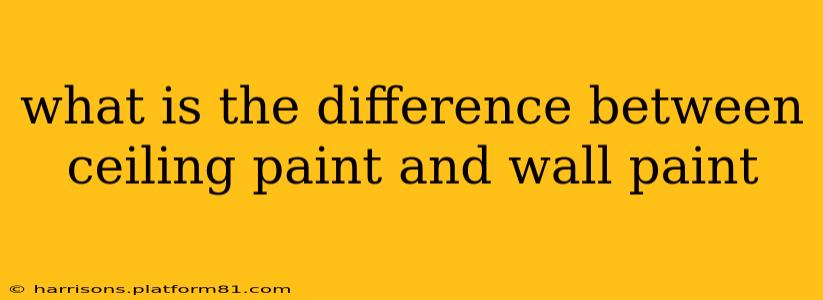Choosing the right paint for your home improvement project can seem daunting, especially when faced with options like ceiling paint versus wall paint. While they might look similar in the paint aisle, there are key differences that impact the final look and longevity of your paint job. This guide will break down those differences, helping you make the best choice for your walls and ceilings.
Why Use Different Paints for Walls and Ceilings?
The primary difference lies in the paint's finish, durability, and hiding power. Ceilings and walls face different wear and tear, demanding paints formulated to withstand those specific challenges.
- Ceilings: Generally require a paint that's easy to apply, dries quickly, and resists cracking or flaking. They're less prone to scuffs and scratches compared to walls.
- Walls: Need a paint that is more durable, scrubbable, and able to withstand bumps, spills, and frequent cleaning.
What are the Key Differences in Paint Properties?
Let's dive into the specifics:
1. Finish:
- Ceiling Paint: Often has a flat or matte finish. This type of finish minimizes imperfections and shadows on the ceiling, making it appear smoother and more uniform. The low sheen also helps to reduce glare.
- Wall Paint: Offers a wider range of finishes including matte, eggshell, satin, semi-gloss, and high-gloss. The choice depends on the desired look and level of durability needed. High-gloss paints are more durable and easier to clean but may highlight imperfections. Matte finishes hide imperfections better but are less scrubbable.
2. Durability and Cleanability:
- Ceiling Paint: Generally less durable than wall paint. While it needs to withstand some wear and tear, it won't face the same level of abuse as walls, making a less robust formula suitable. It's typically not designed for frequent scrubbing.
- Wall Paint: Designed for higher durability and cleanability, especially in high-traffic areas. Paints with eggshell, satin, semi-gloss, or high-gloss finishes are easier to clean and more resistant to scratches and scuffs.
3. Hiding Power:
- Ceiling Paint: Often formulated with high hiding power to cover imperfections and stains on the often-textured ceiling surface. One or two coats usually suffice for a complete and even finish.
- Wall Paint: While hiding power is important, it may not be as critical as for ceilings. The choice of finish also impacts hiding power, with flatter finishes offering better hiding.
4. Drying Time:
- Ceiling Paint: Usually dries faster than wall paint to minimize the inconvenience of working in a room with wet paint.
- Wall Paint: Drying time varies depending on the finish and the specific paint brand.
How to Choose the Right Paint
Considering the specific needs of your space is crucial. When choosing, consider:
- Location: High-traffic areas like hallways or children's rooms require more durable paints. Ceilings typically receive less abuse.
- Finish: Choose a flat finish for ceilings and select a finish for walls based on desired durability and aesthetic appeal.
- Hiding Power: If your ceiling has imperfections, look for a paint with high hiding power.
- Cleanability: In kitchens and bathrooms, choose a more scrubbable paint like satin or semi-gloss.
Frequently Asked Questions (FAQs)
Can I use wall paint on the ceiling?
While you can use wall paint on a ceiling, it's generally not recommended. Wall paint may not have the optimal hiding power or fast drying time ideal for ceilings, potentially leading to a less-than-perfect finish. Additionally, using a higher-sheen wall paint on a ceiling can increase glare.
Can I use ceiling paint on the walls?
Using ceiling paint on walls is also not recommended, especially in high-traffic areas. Ceiling paint lacks the durability and cleanability needed for walls, resulting in a shorter-lasting paint job. Scuffs and marks will appear more easily.
What type of paint is best for a low-traffic area?
In low-traffic areas, a matte or eggshell finish is perfectly suitable for both walls and ceilings. These finishes provide excellent hiding power and a pleasing aesthetic, although their cleanability is limited.
Choosing the right paint for your walls and ceiling is a vital part of any painting project. By understanding the key differences between ceiling paint and wall paint, you can ensure a beautiful, long-lasting, and hassle-free finish.
